Fesenjan is a traditional Persian stew, with fall-off-the-bone tender chicken cooked in a nutty, rich, sweet and sour pomegranate molasses and walnut sauce. Finish this luscious stew recipe with a sprinkle of fresh pomegranate seeds and serve over rice.
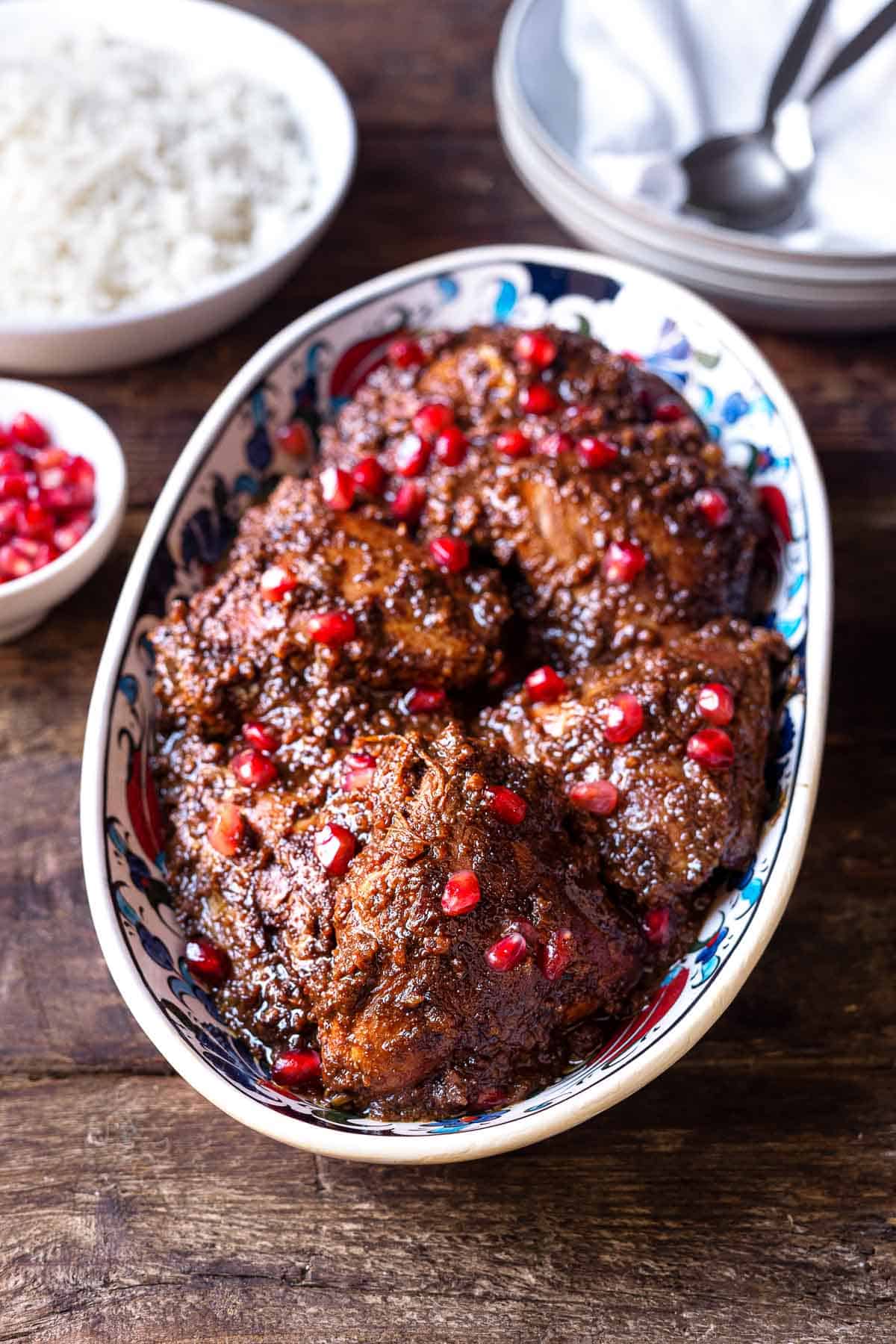
Fesenjan or fesenjoon is a traditional Persian stew made with chicken simmered in a pomegranate molasses and walnut sauce. The combination of earthy walnuts, slightly sour pomegranate molasses and tender, juicy chicken create an unparalleled balance of flavors in this special occasion dish.
This isn’t something you’d throw together on a Tuesday night after work. It requires time for the flavors to meld in a meaningful and memorable way. Save this recipe for a Saturday or Sunday afternoon when you can take your time and enjoy the process.
Once you experience the delight of this savory sweet and sour flavor combination, you’ll wonder how you ever lived without it.
When ready to serve, spoon Fesenjan over basmati rice, saffron rice or tahdig. Round out the meal with a vegetable rich side like tabouli or this simple 3 ingredient Mediterranean salad and enjoy!
Table of Contents
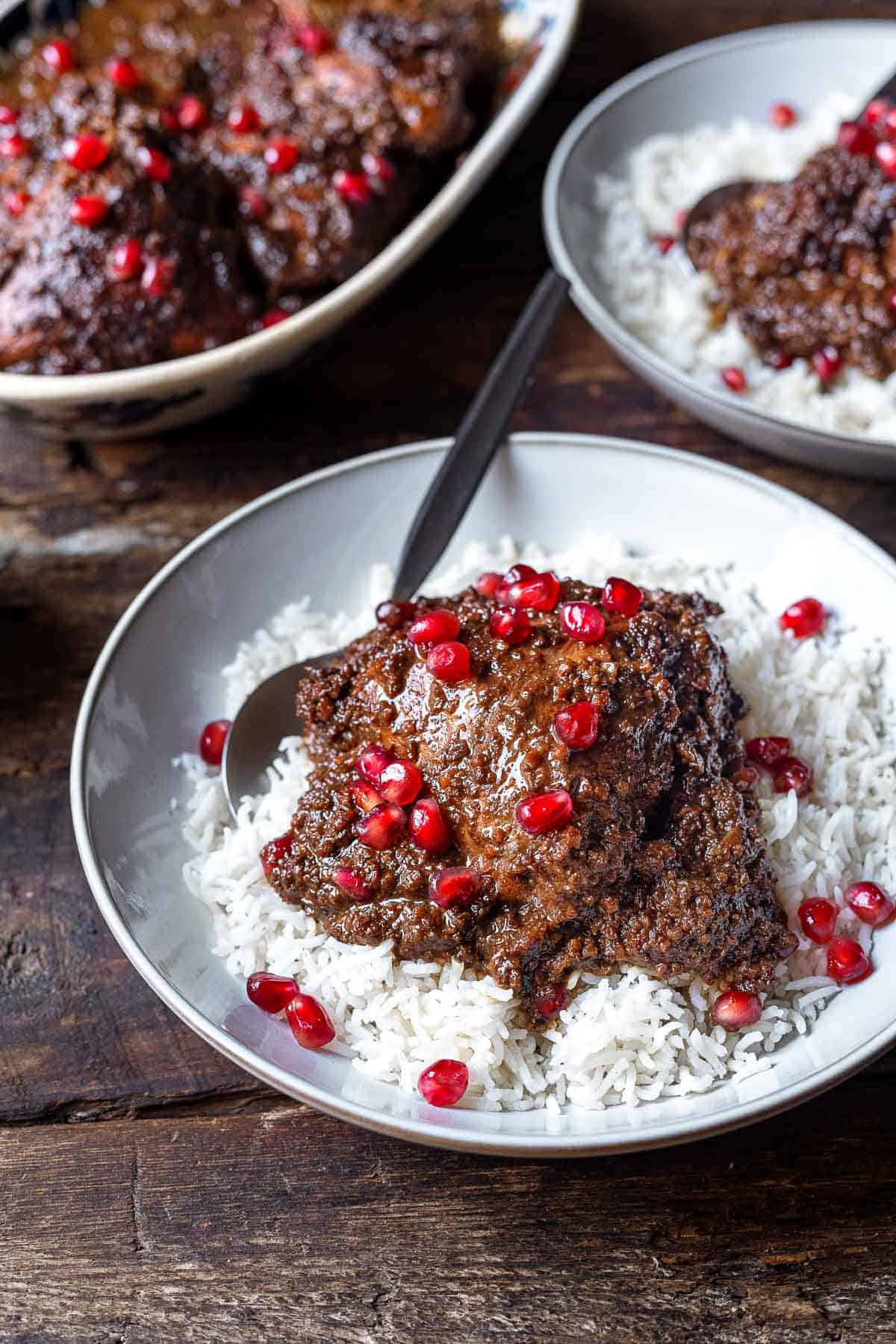
The Origin of Fesenjan
My family eats fesenjan on the night of the Winter Solstice or Shabe Yaldā as we call it. Taking place on the longest night of the year, Yaldā translated from Persian to English means ‘birth,’ which ultimately underpins the essence of this festival.
The festival dates back to ancient times when a majority of Persians were followers of Zoroastrianism. From its Zoroastrian roots, Shab-e Yaldā celebrates the renewal of the sun and the victory of light over darkness – the winter solstice marking the lengthening of days, shortening of nights and the advancement towards spring. Pomegranates are a symbol of this festival so fesenjan is a perfect stew to cook on this special occasion.
Fesenjan originates from Gilan province in northern Iran — a beautiful and lush area near where pomegranate and walnut trees grow in abundance.
In fact, due to this abundance of walnuts and pomegranates several dishes from Gilan use the fruit and nut combination. It’s used in recipes for Kal Kabab, an eggplant, garlic, walnut and pomegranate molasses dip, and Kabab Torsh, chicken or lamb kebabs coated in a walnut and pomegranate paste before cooking over charcoal.
When we serve fesenjan at family parties and special events everyone gathers around the table eagerly waiting to spoon this incredible stew onto their plates. It’s so decadent, people often call it a “rich man’s dish.”
Truly there is nothing out there quite like the combination of meltingly tender chicken, nutty, earthy walnuts and sweet and sour pomegranate molasses.
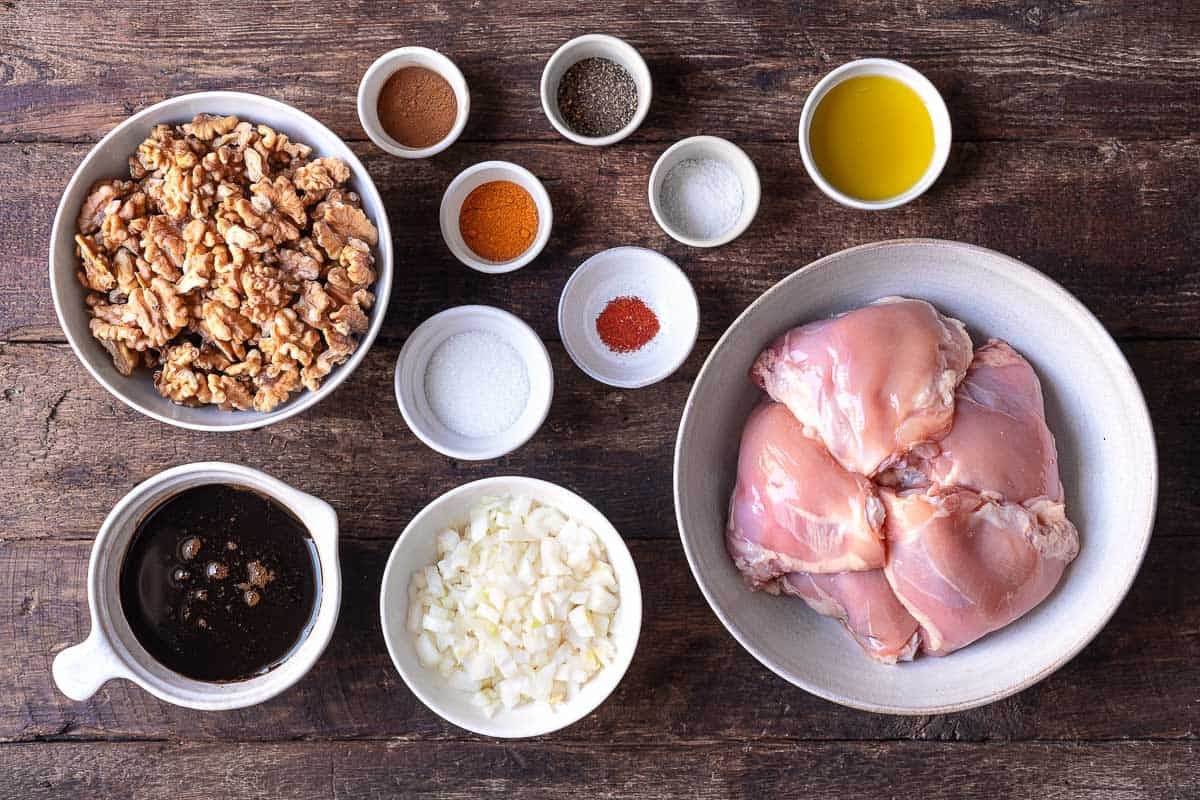
What is in Fesenjan?
Although there are some special ingredients in this recipe, like saffron or pomegranate molasses, I can usually find them at my local supermarket.
However, should your supermarket not stock these ingredients or others, then a Middle Eastern supermarket or shopping online will assist.
- Walnuts: To create the luscious sauce, I finely grind the walnuts.
- Onion: Imbues the dish with a fresh aromatic flavor.
- Chicken Thighs: When it comes to slow-cooking thighs are a top choice. Alternatively, you can use chicken drumsticks or quarters. Remove the skin but leave the bone in for further flavor.
- Extra Virgin Olive Oil: The walnuts release a lot of oil so you only need a little extra virgin olive oil to fry the onions.
- Turmeric, Cinnamon and Saffron: These spices flavor the stew with subtle earthy (turmeric), woody (cinnamon) and floral (saffron) tones. The overall feeling from this stew is warm. If you’re curious about saffron, one of the world’s most interesting spices, learn all about it in our What Is Saffron? Essential Guide.
- Water: The cooking liquid and basis of the rich pomegranate molasses and walnut sauce.
- Pomegranate Molasses: This gives the stew the sour flavor and helps to balance the richness of the walnuts in the sauce. It also gives the fesenjan its beautiful dark brown color. You can purchase it or make it yourself by using this homemade pomegranate molasses recipe.
- Sugar balances and complements the tartness of the pomegranate molasses.
- Salt and freshly ground black pepper elevates the other flavors and adds a subtle heat.
- Pomegranate Seeds: Sprinkle these little jewel-toned bursts of flavor over the top of the stew as a garnish just before serving.
How to Make Fesenjan
Don’t be intimidated by this recipe, it is actually remarkably easy to produce this posh Persian stew. All you need is time and patience—and hopefully a food processor for the walnuts!
- Grind the Walnuts: Grind 3 1/2 cups of walnuts as finely as possible in a food processor. Once the ground walnuts start to clump together you have reached the correct texture. Be careful not to overprocess as you do not want walnut butter.
- Toast the Walnuts: Take a non-stick skillet and place over medium heat. Lightly toast walnuts for a few minutes making sure not to burn them, otherwise the stew will be bitter. Pour the ground walnuts into a bowl and set aside until later.
- Cook Onions: Take a large stockpot or casserole dish with a lid and place over high heat. Add 1 tablespoon olive oil and when it glistens, add 1 finely diced onion. Cook onions until they start to caramelize. Then add 1 teaspoon turmeric and stir into the onion mixture.
- Cook Chicken Thighs: Add chicken thighs and sear for a few minutes on each side. Pour in 3 cups of water and add 1 teaspoon cinnamon. Bring to a boil and then reduce heat to low to allow the stew to simmer for 10 minutes. Remove the chicken from the stew and set aside.
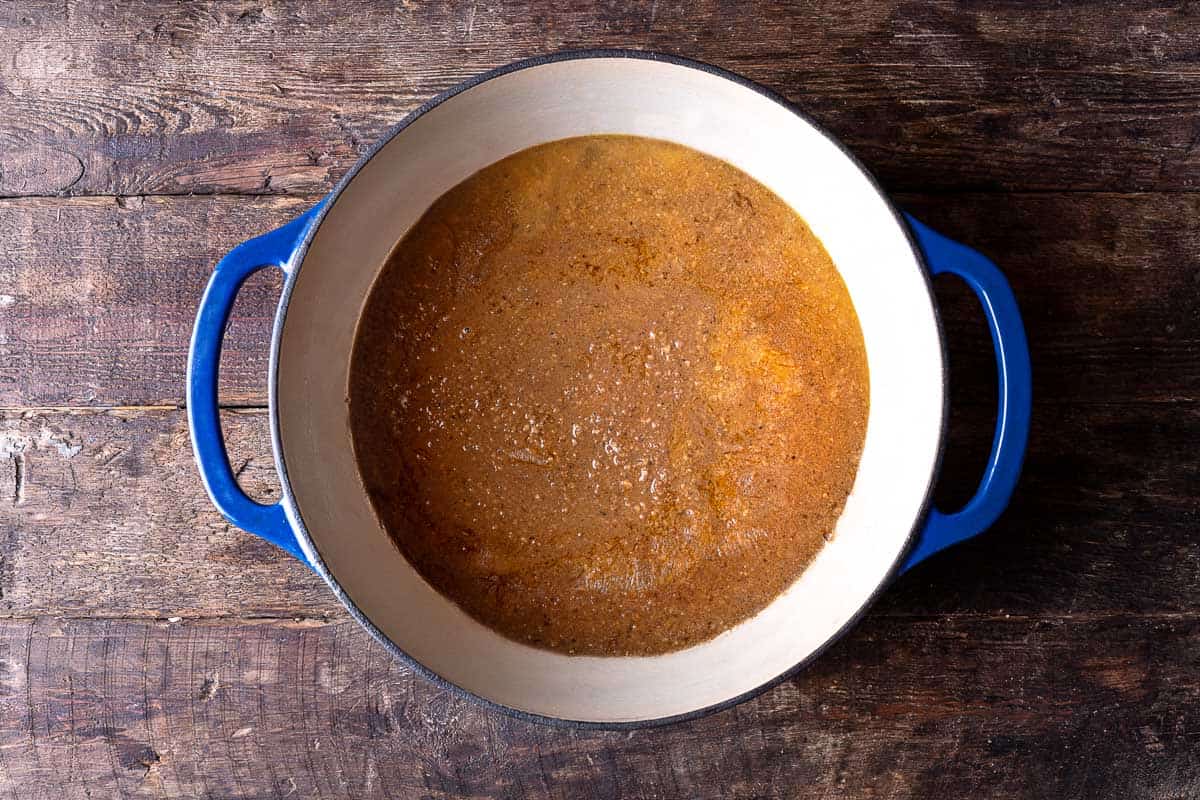
- Add the Ground Walnuts: Pour the ground walnuts into the simmering cooking liquid and stir. Simmer the walnut mixture with the lid on for 1 hour. Stir occasionally throughout to make sure the walnuts do not stick to the bottom of the pan. After the cooking time the walnut sauce should have thickened and darkened in color. There will be a layer of walnut oil on top.
- Add Pomegranate Molasses, Sugar and Saffron: Bloom 1/4 teaspoon ground saffron in 1 tablespoon water for two minutes. Add 3/4 cup of pomegranate molasses, 2 tablespoons sugar and the saffron to the walnut mixture and stir.
- Add the Chicken, Simmer and Season: Add the chicken back into the stew and simmer for a minimum of 45 minutes or until the meat is falling off the bone. You can pull the bones out at this stage or just serve with the bones. It’s up to you. The stew will be a rich dark brown color and the oil from the walnuts will form a layer on the stew. Stir, season and taste. Adjust sweetness, sourness and season to taste.
How to Serve this Persian Chicken Stew
We Iranians believe our stews taste better the day after it has been cooked–from Fesenjan to our famous Ghormeh Sabzi (Persian Beef Stew With Herbs And Dried Lime). We consider the flavors to get to know each other better. We often cook the stew the day before we want to serve it, so feel free to do the same.
To make this stew look a little pretty in light of its rich brown color, sprinkle pomegranate seeds on top as a garnish. Serve with tahdig, crispy Persian rice, plain Greek yogurt and citrus dressed salad on the side.
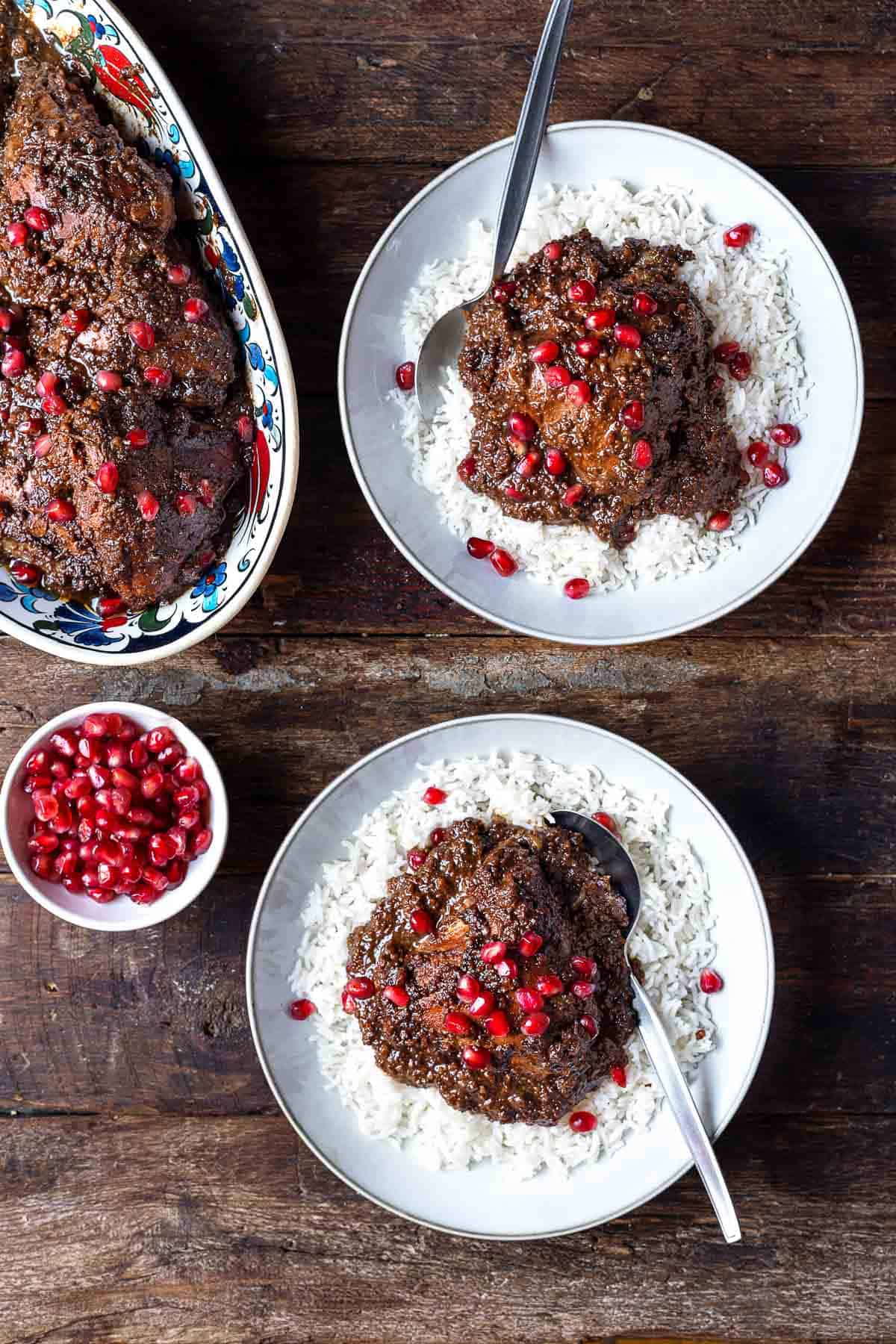
How to Store Fesenjan
If you have any leftovers, store the Fesenjan in an airtight container in the fridge once it has cooled down. It will last up to 4 days.
- To Freeze: Once the fesenjan has cooled down, place it in an airtight container but leave about an inch of space to allow for expansion. Freeze for up to 3 months. Defrost completely before reheating.
- To Reheat: Pour the chicken stew into a saucepan and place over low heat on the stove. You can also reheat in the microwave using the appropriate microwave dish.
Fesenjan Variations
Fesenjan was originally known for being made with duck. The province of Gilan, where fesenjan originated, is not only known for walnuts and pomegranates but also ducks!
Nowadays it is more commonly cooked with chicken, which is a less fatty meat. Some make vegetarian versions using pumpkin, butternut squash or eggplant.
Another variation is how sweet or sour the dish should be. My family loves their Fesenjan to be balanced between these two elements, but it is absolutely fine to adjust the sourness by adding more pomegranate molasses or the sweetness by adding more sugar.
More Tasty Chicken Recipes
Meat and Poultry
Easy Turmeric Chicken
Soups and Stews
Chicken Stew
Meat and Poultry
Easy One-Pot Chicken and Rice
Browse all Mediterranean recipes.
Visit Our Shop.
The Mediterranean Dish Cookbook
The Mediterranean Dish Cookbook brings cross-culturally inspired dishes from the Mediterranean to you, using easy-to-find ingredients and easy-to-follow recipes!
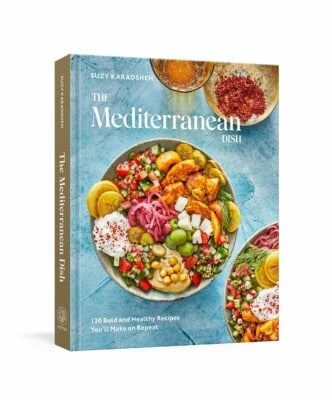
Fesenjan
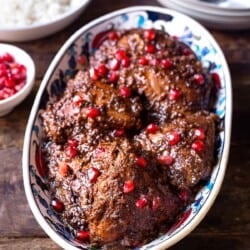
Ingredients
- 3 1/2 cups walnuts
- 1 tablespoon olive oil
- 1 medium onion, finely diced
- 1 teaspoon ground turmeric
- 8 (2 pounds) bone-in chicken thighs, skin removed
- 1 teaspoon cinnamon
- 1/2 teaspoon saffron threads, ground
- 3/4 cup pomegranate molasses, plus more as needed
- 2 tablespoons sugar, plus more as needed
- Fine sea salt, to taste
- Black pepper, freshly ground, to taste
- Pomegranate seeds, for garnish
Instructions
- Grind the Walnuts: Finely grind 3 1/2 cups of walnuts in a food processor until they start to look like sand that clumps together. Do not over process. You don’t want to end up with walnut butter.
- Toast the Walnuts: Place dry non-stick skillet over medium heat. Lightly toast walnuts, stirring continuously for a few minutes until you can smell the aroma from the ground nuts, making sure not to burn them. Pour toasted ground walnuts into a bowl and set aside until ready to use.
- Cook Onions: Take a large stockpot or Dutch oven with a lid and set over high heat. Add 1 tablespoon olive oil. When olive oil glistens, add 1 finely diced onion. Cook onions until they start to caramelize and turn golden brown. Then add 1 teaspoon turmeric and stir into onion mixture.
- Cook Chicken Thighs: Add chicken thighs and sear for a few minutes on each side. Pour in 3 cups water and add 1 teaspoon cinnamon. Bring to a boil and then reduce heat to low to allow stew to simmer for 10 minutes. Then remove chicken and set aside.
- Add the Ground Walnuts: Pour ground walnuts into the simmering cooking liquid and stir. Place the lid back on the pot and simmer the walnut mixture for 1 hour. Stir occasionally throughout to make sure walnuts don’t stick to the bottom of the pan. After the cooking time the walnut sauce should have thickened, darkened in color until its deeply golden like tahini or honey and there will be a layer of walnut oil on top.
- Bloom Saffron, add Pomegranate Molasses, Sugar: In a small bowl add 1 tablespoon of water. Using a mortar and pestle or a spice grinder add the 1/2 teaspoon of saffron threads and grind. You should end up with about 1/4 teaspoon ground saffron. Add the 1/4 teaspoon of ground saffron to the 1 tablespoon of water. Into the pot with the walnut mixture, add 3/4 cup of pomegranate molasses, 2 tablespoons sugar and bloomed saffron. Stir to combine.
- Add Chicken, Simmer and Season: Add chicken back into stew and simmer for 45 minutes or until the meat is falling off the bone. The stew will be a rich dark brown and the oil from the walnuts will form a layer on the stew. Stir, season and taste. Adjust sweetness, sourness and seasoning to taste.
- Serve the Fesenjan: Ladle the fesenjan into a serving dish and sprinkle with pomegranate seeds to garnish. Serve with rice, Greek yogurt and a side salad.
Notes
- Visit our shop to browse quality Mediterranean ingredients including olive oils, honey, jams and spices.
- If you can’t find pomegranate molasses in the store you might be able to find pomegranate juice. If that’s the case just reduce the juice and you will have molasses! Need more details? Follow our recipe for Homemade Pomegranate Molasses.
- Make this recipe when you have time to let it simmer for 2 hours. It’s worth the wait.



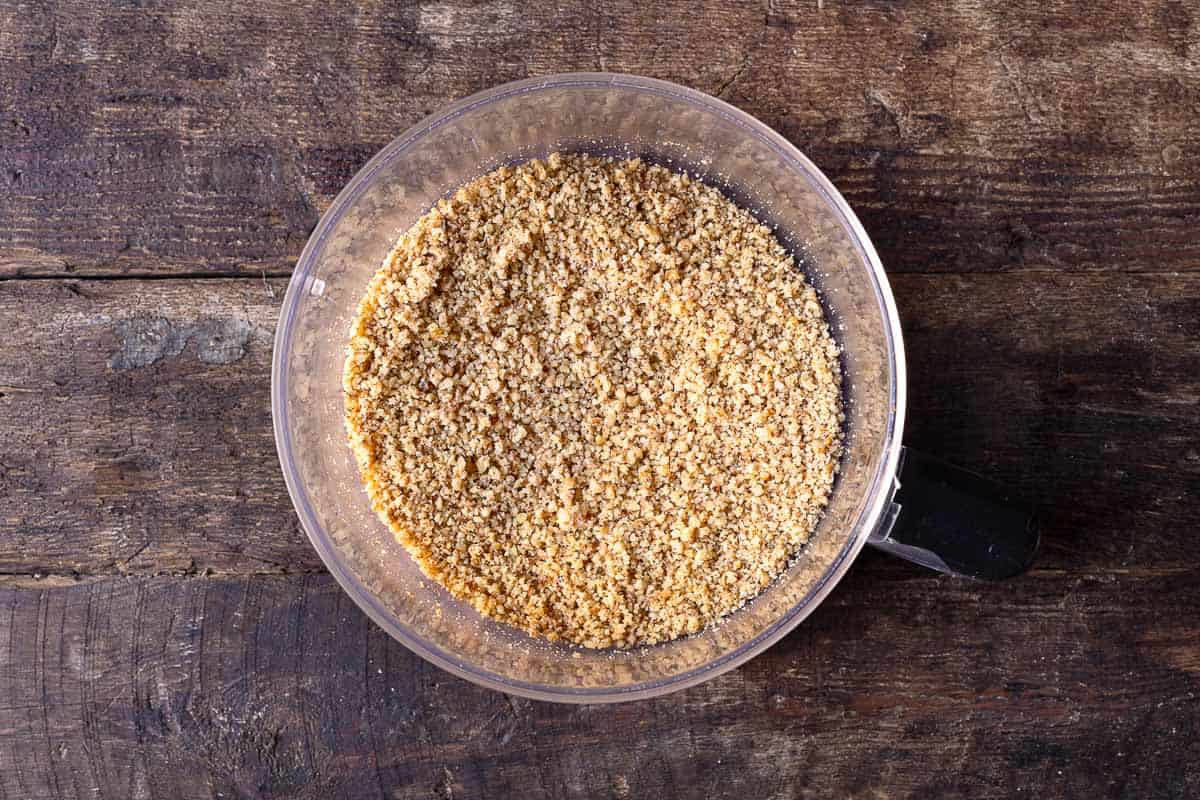
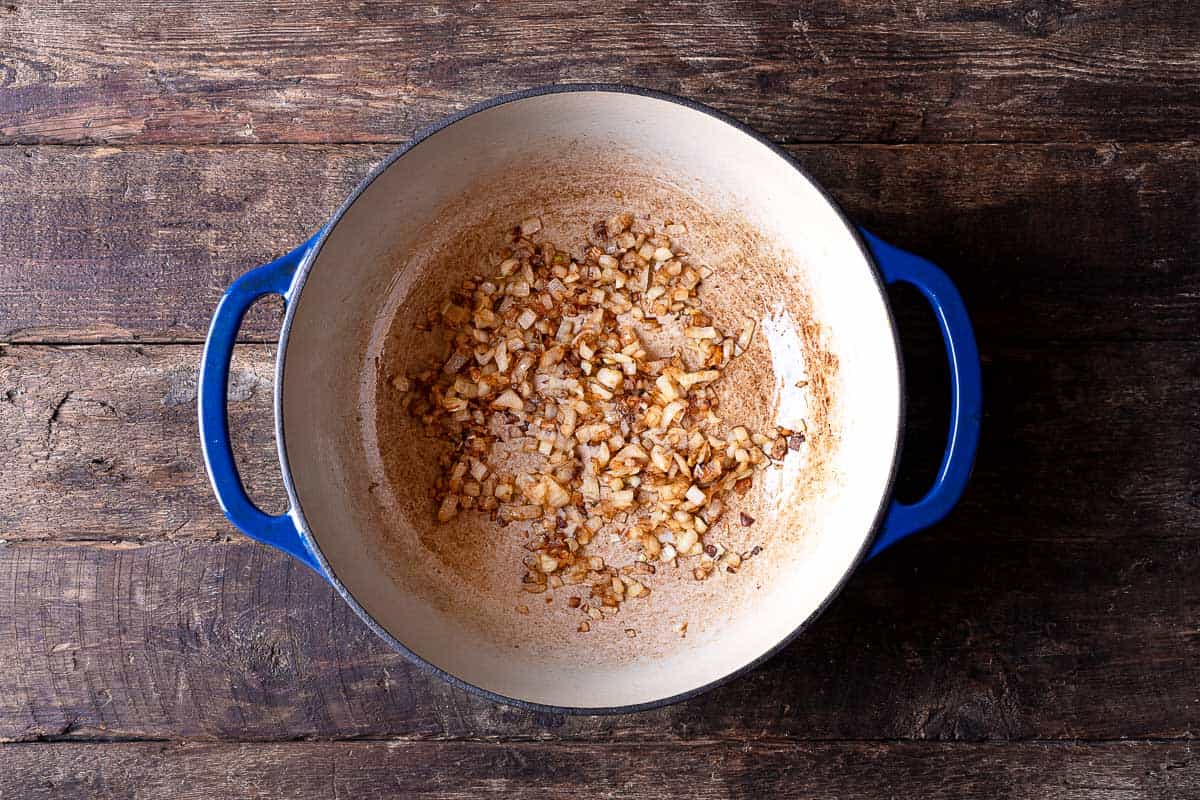

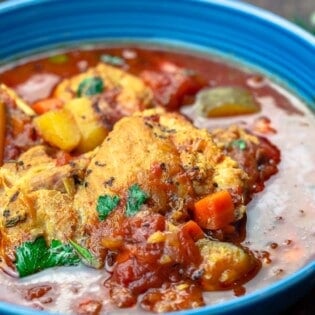

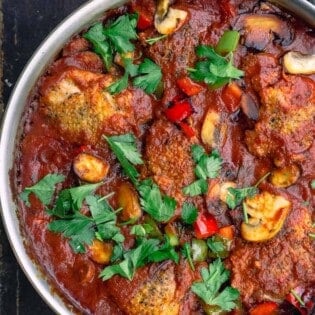
It was okay. Time consuming and lots of calories. I wouldn’t make it again.
Absolutely delicious! Everything came out perfectly balanced without having to adjust for other than salt, and I was told by my guests this was in the top ten of homemade dishes they’d ever had. Also, have to second what others are saying. It is actually quite a simple recipe – just a bit time consuming.
Thanks, Astrid! Appreciate you taking the time to leave your feedback!
I appreciate your website very much; thank you. I’m curious why in this recipe you don’t brown the chicken thighs first and then sautee the onions in the chicken fat. Any particular reason for the order of those steps? Thanks again!
As you are based in the UK it would help if you were to use metric measures rather than cups and pounds please.
Lovely recipes but I have had to do the conversions.
Reminds me of travels in Iran.
I’m so glad I stumbled upon this recipe. While this recipe is time consuming, the actual instructions are easy and the prep time is an ok amount. I didn’t have saffron, so omitted that ingredient. The end result tasted just like the Fesenjan that I get at my local Persian restaurant. SO GOOD!
Thanks so much, Laura!
I have used many of your excellent recipes, but I have to say this might be my favorite!! This was just incredible!!
I made a vegan version of this, just exchanging the chicken for vegan fillet pieces and it worked really well. The sauce darkened nicely and was full of flavour. It is the best fesenjan recipe I have tried.
Hi Brian, Devin here from the Mediterranean Dish team. I’m so happy to hear this recipe turned out so well & thank you so much for sharing your tweaks to make this vegan!
Really delicious, chicken was so tender. Different flavours than I’m used to and I enjoyed it!
Served it with basmati rice flavoured with tumeric, and a refreshing side salad (Maroulosalata from this site!)
Hi, Sam! I’m Summer and I work here at The Mediterranean Dish! So glad you tried some new-to-you recipes and loved them. Thanks for taking the time to let us know!
Lots of work. I found the dish to very sour. I added more sugar which did help. I brought some down to my Iranian neighbor. She said that it was very good, and did I make it? I took that as a compliment, but I am not sure that I would make this again. I also found that adding some salt to individual portions helped. Must be an acquired taste. Nonetheless, I will try other Persian dishes as well.
Thanks for the feedback, Jan!
What does it mean with 8 2 pound chicken thighs? So 16 pounds total?
Hi, Alexandra. 8 (2 pounds) bone-in chicken thighs means you need 8 bone-in chicken thighs. 8 chicken thighs typically weigh about 2 pounds total.
I tried this dish at the Persian restaurant and LOVED it. So I found your recipe and repeated it. Wondering whether the quality will suffer is the walnuts are stewed for less time, otherwise it came out very nice. Thank you for the recipe!
Hi, Olga. I wouldn’t think the quality would necessarily suffer if you reduced the stewing time for the walnuts just bit. Hard to be 100% certain though, as we haven’t tested any other amount of time. Would love to get your feedback if you give it a try.
Hi there my son is allergic to tree nuts.
Is there something else he can substitute it with
You could try sunflower seeds?
Thanks a lot for the Excellent recipe.